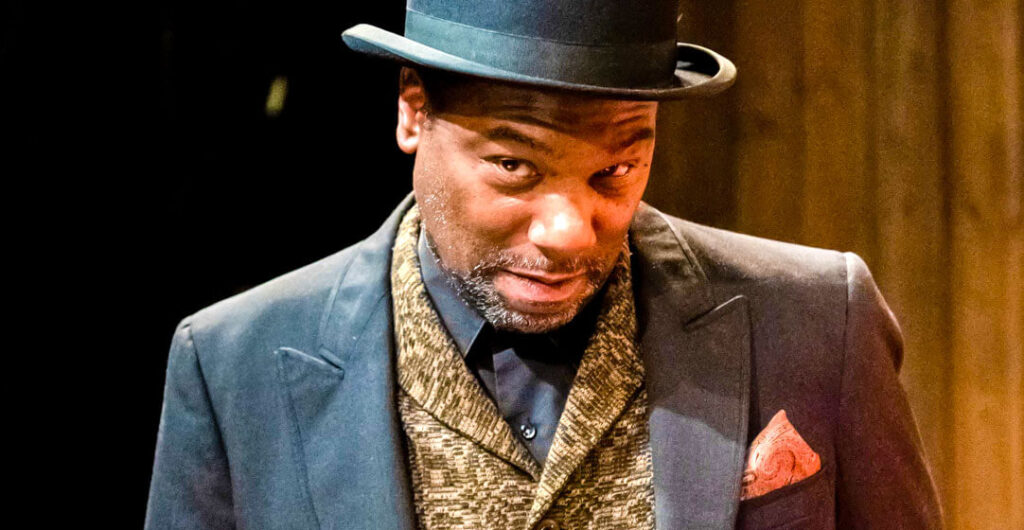Seattle’s Act Theatre stages world premiere of “History of Theatre: About, By, For, and Near”
Three tumultuous events had just happened within the Pacific Northwest theater scene in the summer of 2020 when Seattle actor/playwright Reginald André Jackson started writing his new play “History of Theatre: About, By, For, and Near.”
The COVID lockdowns were in force. This was a devastating time for American theater companies. Secondly, the Black Lives Matter movement was gaining momentum in the wake of several nationally reported acts of violence against African Americans. Also, within the theater community itself, hundreds of Black, Indigenous and people of color had signed a document calling for an aggressive approach to stamping out racism in the theater industry and demanding more representation.
Given the times, Jackson and his colleagues at ACT Theatre felt the largely forgotten 200-year history of African American theater and its personalities needed to be told.

“I started talking to John Langs, the artistic director at ACT about what we could do,” Jackson said during a January interview with AAA Washington. “This was initially going to be a Zoom presentation that talked about the history of African American theater. It was later decided that these stories were important enough to be put on the stage.”
“History of Theatre: About, By, For, and Near” charts the course of Black theater from 1820 to the mid-1930s. Personalities and pioneers of the African American stage come to life, such as Pat Chapelle (who founded the first touring vaudeville act in 1900), Ira Aldridge, Rose McClendon and Seattle’s Negro Repertory Co. — as well as other performers of the past whom Jackson calls the “unsung pioneers of American theater.”
Ahead of the play’s world premiere in Seattle (see details here and below), Jackson spoke more about the play with us.
Can you talk a little about the play’s story?
You will watch a theater artist who is grappling with the aftermaths of the shutdown and the Black Lives Matter movement, together with the “We See You, White American Theater” document that dropped during the shutdown as well.
They are creating a theatrical piece that spans the history of African American theater. So, they call together a group, an ensemble working here not quite 100 years ago in the U district that was part of the federal theater project. There was a black unit in the U district. She (Sister Blacknall, one of the principal characters in the play) manages to go back in time and grab this ensemble, and she is basically going to have to portray historical figures throughout time. She interviews them, and they improvise situations that they would have been in during their lifetimes.
What sort of emotions are you trying to elicit from your audience. Is it laughter? Very serious?
I think it is all of that. We are looking at sort of the breadth of humanity, so you go back 200 years or 100 years ago and look at what artists were doing. The things that they were accomplishing were amazing, especially given the circumstances and the racism that they were dealing with.
I imagine that people will feel a little bit about what has changed and what hasn’t changed, what still needs to be worked on. You have to deal with minstrelsy and blackface, and vaudeville. We see the first superstars of the African American stage, and we talk about the first theater that was built in the United States for people of color.

Where did you find the words for your characters?
They lived a century or two before me, so I certainly didn’t know them. I’ve heard of some, but one of the refrains I keep hearing is: ‘Why didn’t I know this, why didn’t I hear this, why wasn’t I taught this?’
A lot of these artists frankly just aren’t present enough in our history, our books. We have people like Ira Frederick Aldridge and Paul Robeson, and people like that who people know, but people don’t necessarily know The Hyers Sisters or William Alexander Brown. People might know Bert Williams because of minstrelsy and blackface, but there is Sissieretta Jones and Aida Overton Walker.
There are a lot of people who you just don’t have any information about; the information hasn’t been readily available. So, I just put myself in their situation. Sometimes, I have quotes and that inspires dialogue but I look at the situation that they have been through and we, as best we can, try to recreate some of them.
Your play seems to be a natural fit to run during Black History Month in February.
We weren’t necessarily targeting February, but when it fell out that way that that was when it could happen, it just made sense because it is Black History Month, and we are telling stories from history.

Was there a lesson that you hope people take home?
I would hope that they would look at what these people have experienced and try to frame it in our current situation in what is happening in today’s theater. There is already a call for different types of stories and from a more diverse group of people; that we look at the power structure of the theater and look at whose stories are being told and how welcoming we are to people of color to come to these spaces and watch these shows.
We are in no way promoting that people see the document, “We See You, White American Theater,” but the play asks us to ask some of the same questions that that document does; and to ask how to proceed and to look at and learn from what has happened before and why are some of these same things still happening.
Do you have any final thoughts about the play?
Just that some of these stories really are remarkable, and it was amazing to see what people were able to accomplish during the time period that they are in, and there’s a lot of good humor and spirit and fun to be had.
History of Theatre is an ensemble piece with each of the actors portraying a variety of historical and modern figures. Directed by Valerie Curtis-Newton. The play previews at ACT Theatre at 700 Union St. in Seattle on Jan. 28-29 and Jan. 31-Feb. 1. Opening night is Feb. 2. The play runs through Feb. 12.

Road Trip Tips
Before you go: Get ready for your road trip with a AAA Membership. Get peace-of-mind on the road plus travel and insurance services and much more.
Save on hotels and rental cars: Unlock savings on hotels with a AAA membership. Plus, AAA members save up to 20% with Hertz.
Save on car insurance: AAA members save up to 8% on car insurance.
Get battery service: AAA Mobile Battery Service uses state-of-the-art technology to accurately diagnose battery-related problems. We’ll even replace your battery with a brand-new one if necessary, at a special member price.
Save with AAA member discounts: AAA membership gives you access to exclusive entertainment discounts nationwide.
—Written by Victor Whitman
—Top photo is of the cast of “History of Theatre.” Photo is by Robert Wade.









